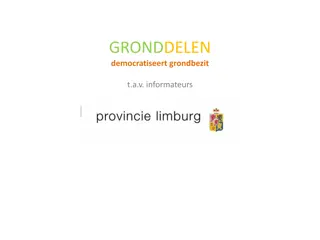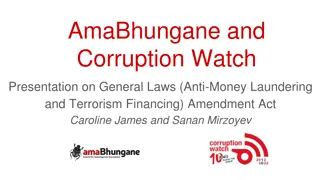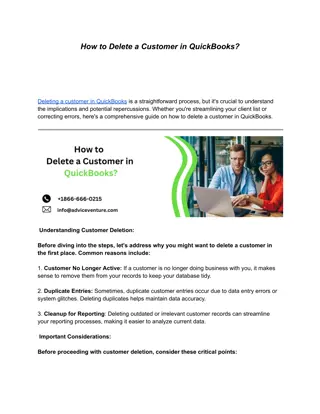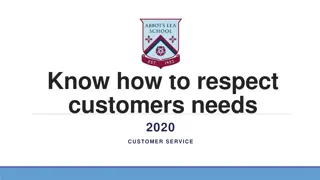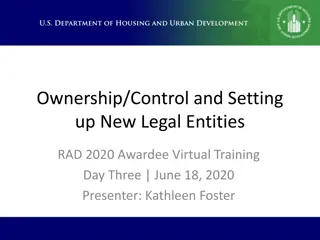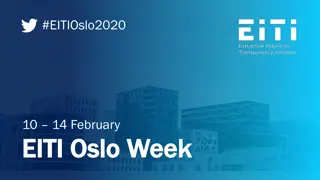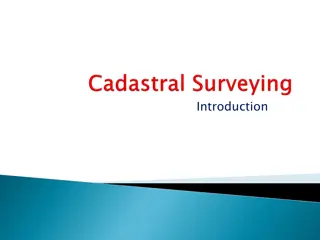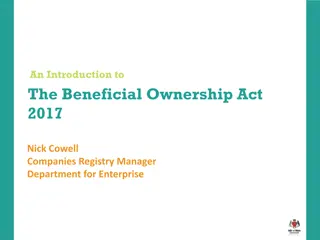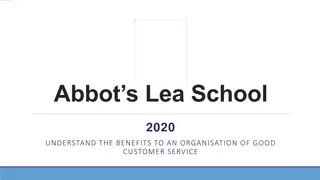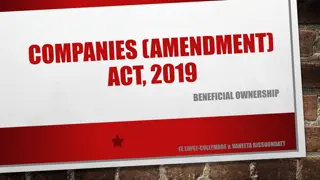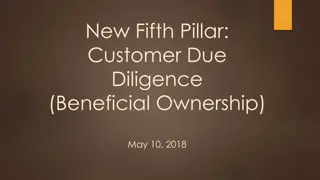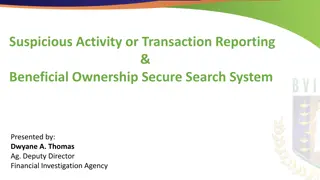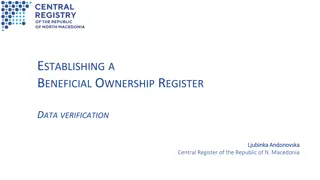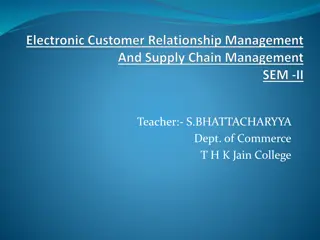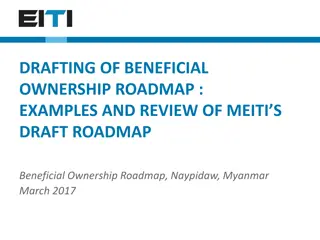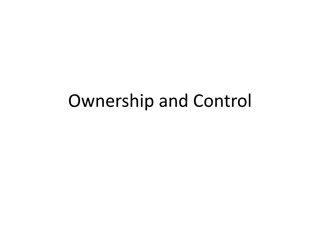Beneficial Ownership and Customer Transparency
Explore the importance of beneficial ownership in financial institutions, aligning regulatory requirements, and best practices for customer transparency. Learn about FATF recommendations, the significance of the Panama Papers leak, and regulatory timelines for rulemaking.
Download Presentation

Please find below an Image/Link to download the presentation.
The content on the website is provided AS IS for your information and personal use only. It may not be sold, licensed, or shared on other websites without obtaining consent from the author.If you encounter any issues during the download, it is possible that the publisher has removed the file from their server.
You are allowed to download the files provided on this website for personal or commercial use, subject to the condition that they are used lawfully. All files are the property of their respective owners.
The content on the website is provided AS IS for your information and personal use only. It may not be sold, licensed, or shared on other websites without obtaining consent from the author.
E N D
Presentation Transcript
BENEFICIAL OWNERSHIP ARE YOU PREPARED? September 19, 2017 Lyn Hall-Fore US Director of BSA/AML BBVA Carol Beaumier Managing Director Protiviti
Agenda Customer Transparency - Background CDD Regulatory Requirements Alignment with Other Regulatory Requirements Best Practices and Recommendations Where Do We Go From Here? 2
Customer Transparency FATF Recommendations 5, 24 and 25 PREVENTIVE MEASURES 5. CDD should include Identifying the beneficial owner, and taking reasonable measures to verify the identity of the beneficial owner, such that the financial institution is satisfied that it knows who the beneficial owner is. For legal persons and arrangements this should include financial institutions understanding the ownership and control structure of the customer TRANSPARENCY AND BENEFICIAL OWNERSHIP OF LEGAL PERSONS AND ARRANGEMENTS 24. Transparency and beneficial ownership of legal persons: adequate, accurate and timely information on the beneficial ownership and control of legal persons 25. Transparency and beneficial ownership of legal arrangements: adequate, accurate and timely information on express trusts, including information on the settlor, trustee and beneficiaries. 3
FATF Mutual Evaluation Report 2006 Measure Rating Relevant Comments Customer Due Diligence PC No obligation in law or regulation to identify beneficial owners except in very specific circumstances (e.g., correspondent banking and private banking. 2014 Legal Persons NC No measures in place to ensure that there is adequate, accurate and timely information on the beneficial ownership and control of legal persons that can be obtained or assessed in a timely fashion by competent authorities. 2012 2010 Legal Arrangements NC There is minimal information concerning the beneficial owners of trusts that can be obtained or assessed by the competent authorities in a timely manner. 4
Significance of the Panama Papers May 2016: The Panama Papers leak identifies nearly 214,000 of dollars in assets that were created by intermediaries in 21 jurisdictions. 214,000 accounts with trillions Top 10 Jurisdictions Source: The Panama Papers, ICIJ The leak sparked outrage over the lack of financial transparency and the ease by which people good and bad - were able to hide their assets. Searchable database for the Panama Papers: https://offshoreleaks.icij.org. 5
CDD Regulatory Requirements Rulemaking Timeline Advanced Notice of Proposed Rulemaking U.S. Final Rule Published in Federal Register Notice of Proposed Rulemaking Regulatory Impact Assessment Treasury Announces Final Rule March 2012 August 2014 December 2015 May 6, 2016 May 11, 2016 Covered financial institutions (FI) have 2 years to implement: May 11, 2018 The four CDD core elements and beneficial ownership requirements were clarified in new the guidance. The CDD regime serves various processes: Assists in financial investigations by law enforcement. Enhances to the ability to assess and mitigate risk and comply with existing requirements. Facilitates reporting and investigations in support of tax compliance, including FATCA. Promotes consistency in CDD expectations across all financial sectors. 7
Customer Due Diligence/Beneficial Ownership Requirements Pillars of BSA AML Program 1. Customer Identification and Verification 2. Beneficial Ownership Identification and verification. [31 CFR 1010.230] 3. Establish risk based procedures for conducting ongoing customer diligence. Amends BSA to add 5th Pillar. [31 CFR 1020.210] Understand nature & purpose of account; Ongoing monitoring, suspicious activity reporting and on risk basis update of customer information. Customer Due Diligence Customer Due Diligence (CDD) amends BSA to add 5th Pillar by May 11, 2018 New Requirements 8
BSA/AML Program Changes The CDD rule requires covered institutions to establish risk- based procedures with more thorough coverage of customer relationships Shift from rules based risk ratings to a risk based approach to a calculate AML risk profile Formalizes Customer Identification Program (CIP) and adds new requirements to Know Your Customer (KYC) expectations including: 25% Beneficial Ownership (B/O) Controlling interest on accounts 9
Identify Natural Persons If not a person, obtain ownership of 25% or more in non-publically traded companies or legally formed entities such as limited liability corporations (LLCs) and privately held companies, etc. 10
Beneficial Ownership Title 31 C.F.R 1010.230 requires covered FIs to proactively identify and verify the identify of beneficial owners for each legal entity at account opening. Beneficial Ownership Types Control Prong Ownership Prong Each individual, directly or indirectly through any contract or arrangement, understanding or relationship that owns 25% or more of the equity interests (broadly defined as an ownership interest in a business entity) Require ID of no more than 4 persons, if no person meets 25%, then none need to be identified. Directly and indirectly signifies that the covered FI s customer must identify its ultimate beneficial owners(s) and not nominees or straw men, FIs may designate a threshold below 25% based on their own risk assessment. A single individual with significant responsibility to control, manage or direct a legal entity customer. The legal entity customer must provide identifying information for one person with significant managerial control. In some cases a person may satisfy both the ownership and control prong. Examples can include an Executive Officer or Senior Manager, CEO, CFO. Managing Member, General Partner, Present, Vice President or Treasurer or any person who performs similar functions. Beneficial owners are persons meeting either the Ownership or Control Prongs. Rule does not apply retrospectively for existing customers. Does apply after the rule goes into affect for existing customers establishing new accounts. 11
Correspondent and Private Banking Section 312 of the USA PATRIOT Act requires the following Section 312 of the USA PATRIOT Act requires the following : : For foreign financial institutions that operate under an offshore license; operate in a jurisdiction that has been designated as non- cooperative with international AML standards and/or operate in a jurisdiction designated by the Secretary of Treasury as warranting special measures: identify all persons who own, control or have the power to vote 10% or more of any class of securities of any non-publicly-traded company. For private banking accounts, identify the nominal and beneficial owner* of the account. *Beneficial owner of an account means an individual who has a level of control over, or entitlement to, the funds or assets in the account that, as a practical matter, enables the individual, directly or indirectly, to control, manage or direct the account. 12
Other Regulatory Requirements Financial institutions may need to consider other definitions of beneficial ownership, including, but not limited to: o 4th EU Directive: natural person who ultimately holds a shareholding, ownership interest or controlling interest of more than 25% shares or voting rights in a corporate entity. o OFAC 50% Rule: an entity owned in the aggregate, directly or indirectly, 50% or more by a blocked person shall itself be considered to be a blocked person. o FACTA: a substantial owner of a corporation means any US person that owns, directly or indirectly, more than 10% of the stock of the corporation. 13
Institutions will be expected to: Manage their frontline personnel and processes with more precision to collect data Using a multi-layered approach to their procedures, testing and monitoring of customer risk through AML risk profiles These requirements likely will result in the need for increased staff resources and advanced technology Source: www.fisglobal.com/RISC - Center for Regulatory Intelligence, Regulatory Intelligence Briefing: Special Edition: 2016 year in Review and 2017 Outlook 14
Example CDD Workflows Meet strategic goals of improving customer on-boarding experience and client retention with improved Know Your Customer (KYC) processes New regulation for customer due diligence (CDD) and beneficial ownership (B/O) identification deadline May 2018 Technical and process changes impact multiple areas of the bank including branch and digital projects with opportunity to improve customer on-boarding experience including TCR (Transparent, Clear and Responsible) USA Project Four main workflow for KYC Transformation Project have been established and divided into BSA program changes, technical enhancement and bank transformation tracks Track 1 Track 2 Track 3 Track 4 Meet new CDD requirements (2 Phases) Update core system of record fields to capture additional customer data Implement Beneficial Ownership identification process Update account disclosures regarding obtaining CDD and 25% B/O Risk rate each customer for AML controls at acquisition and continuous monitoring Change on-boarding from rules based to risk based approach Implement Global RBA model Process enhancement for customer on- boarding using case management system risk scoring and case management
Best Practices & Recommendations Centralize the process/policy development for determining beneficial ownership to ensure all legal and regulatory requirements are met. Understand and address the technology needs NOW. Ensure customer opening docs/processes are modified to capture necessary information. Ensure that consideration of beneficial ownership requirements is incorporated correctly throughout the AML program, e.g., policies and procedures, training, KYC and customer risk ratings, monitoring, reporting and recordkeeping, etc. Train all affected personnel before the go-live date. Make sure Internal Audit includes compliance with the new requirements in its 2018 planning. 16
Where Do We Go From Here? 2016 Mutual Evaluation Report Lack of timely access to adequate, accurate and current beneficial ownership (BO) information remains one of the fundamental gaps in the U.S. context. 17
Three Legislative Changes to Watch: 1. H.R. 3089 - Corporate Transparency Act of 2017 Link: https://www.congress.gov/bill/115th-congress/house-bill/3089/text To ensure that persons who form corporations or limited liability companies in the United States disclose the beneficial owners of those corporations or limited liability companies at FinCEN if not collected by the State of Incorporation 2. Executive Orders 13771 and 13777 Link: https://www.gpo.gov/fdsys/pkg/FR-2017-06-14/pdf/2017- 12319.pdf?utm_campaign=AML%20-%20Newsbytes%20-- %2020170707&utm_medium=email&utm_source=Eloqua Directed agencies to eliminate two regulations for each new regulation issued and to limit costs for this fiscal year to zero and to create a task force for implementation 3. FFIEC BSA/AML Exam Manual updates to the 2014 version Customer Due Diligence and Beneficial Ownership revisions 18
Questions 19


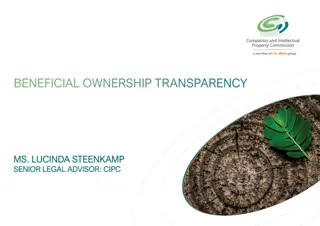
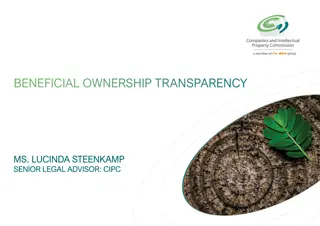

![Enhancing Corporate Transparency: Analysing The Companies Amendment Bill [B27B-2023]](/thumb/60028/enhancing-corporate-transparency-analysing-the-companies-amendment-bill-b27b-2023.jpg)
